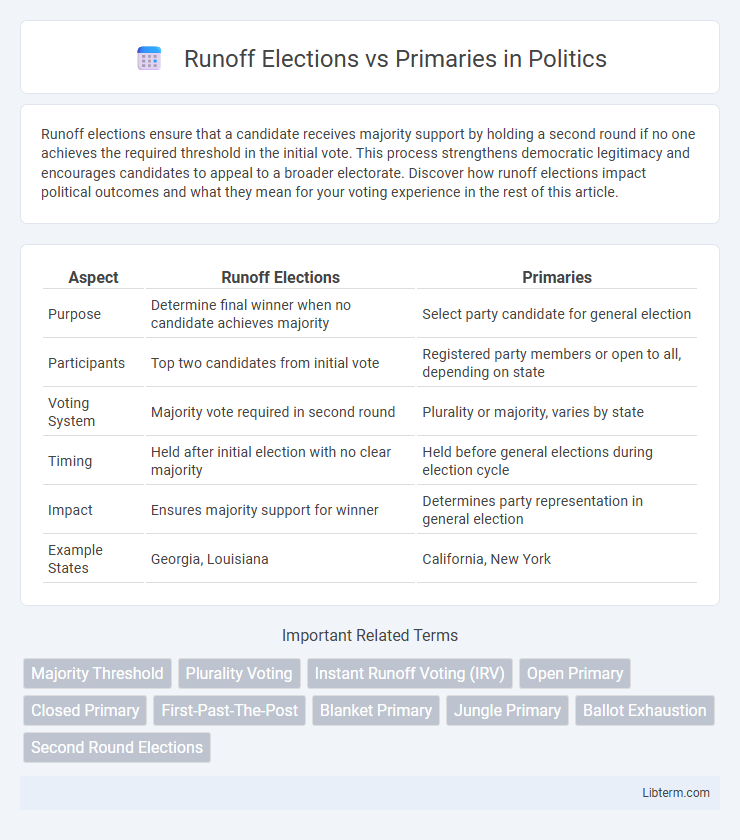Runoff elections ensure that a candidate receives majority support by holding a second round if no one achieves the required threshold in the initial vote. This process strengthens democratic legitimacy and encourages candidates to appeal to a broader electorate. Discover how runoff elections impact political outcomes and what they mean for your voting experience in the rest of this article.
Table of Comparison
| Aspect | Runoff Elections | Primaries |
|---|---|---|
| Purpose | Determine final winner when no candidate achieves majority | Select party candidate for general election |
| Participants | Top two candidates from initial vote | Registered party members or open to all, depending on state |
| Voting System | Majority vote required in second round | Plurality or majority, varies by state |
| Timing | Held after initial election with no clear majority | Held before general elections during election cycle |
| Impact | Ensures majority support for winner | Determines party representation in general election |
| Example States | Georgia, Louisiana | California, New York |
Understanding Runoff Elections
Runoff elections occur when no candidate achieves the required majority in a primary or general election, necessitating a second round between the top contenders to determine the winner. This process ensures that the elected candidate has broad support, often leading to more decisive outcomes than plurality-based primaries. Understanding runoff elections is key to analyzing voter behavior and election strategies in states like Georgia and Louisiana where runoffs are common.
What Are Primary Elections?
Primary elections determine a political party's candidate for the general election by allowing party members to vote directly for their preferred contender. These elections can be open, closed, or semi-closed, impacting voter eligibility and participation. Primary elections streamline the candidate selection process, promoting democratic engagement within political parties.
Key Differences Between Runoff Elections and Primaries
Runoff elections occur when no candidate achieves the required majority in the initial voting round, leading to a follow-up contest between the top candidates, while primaries are preliminary elections held within a party to select a nominee for the general election. Runoff elections typically narrow the field from multiple candidates to two, ensuring a majority winner, whereas primaries focus on party member preferences and can be open, closed, or semi-closed. The strategic implications differ, with runoffs emphasizing broad voter appeal to secure majority support, whereas primaries often target party activists and base voters.
Historical Origins of Runoff Elections and Primaries
Runoff elections originated in the late 19th century as a solution to ensure majority support for elected officials, often replacing plurality wins in single-round elections, particularly in Southern U.S. states like Georgia and Louisiana. Primaries emerged in the early 20th century during the Progressive Era as a reform to increase democratic participation by allowing party members to select candidates directly, reducing the influence of party elites. Both systems transformed the electoral process by enhancing voter engagement but serve different functions: primaries narrow the field of candidates within a party, while runoffs determine the ultimate winner when no candidate achieves a majority initially.
How the Runoff Process Works
The runoff election process occurs when no candidate secures the required majority vote in the initial primary, typically over 50%, prompting the top two vote-getters to compete in a subsequent election. This system ensures that the eventual nominee has majority support rather than a mere plurality, strengthening electoral legitimacy. Runoff elections are commonly used in states like Georgia and Louisiana, impacting candidate strategies and voter turnout dynamics.
Types of Primaries Explained
Closed primaries restrict voting to registered party members, ensuring only loyal party affiliates select candidates. Open primaries allow any registered voter to participate, increasing voter flexibility but risking crossover voting. Runoff elections occur when no candidate achieves a majority, leading the top two contenders to face off in a decisive second round.
Pros and Cons of Runoff Elections
Runoff elections ensure majority support by requiring a second round if no candidate achieves over 50% in the primary, enhancing voter legitimacy and representation. However, they can lead to lower voter turnout in the runoff phase, increasing election costs and voter fatigue. The extended election process may also disadvantage lesser-known candidates due to limited resources for prolonged campaigning.
Pros and Cons of Primary Elections
Primary elections offer a direct way for party members to select candidates, promoting greater voter participation and reflecting grassroots preferences. However, this method can lead to lower turnout compared to general elections and may encourage candidates to cater to extreme party bases, potentially polarizing the electorate. Costs associated with primaries are also significant, requiring substantial financial and administrative resources.
Impact on Voter Turnout and Engagement
Runoff elections often experience lower voter turnout compared to primaries, as voter fatigue and extended election timelines diminish engagement. Primaries typically attract higher participation due to their role in narrowing candidate fields early in the election cycle, providing voters with more influence in selecting party nominees. Studies indicate that runoff elections can deepen political polarization by mobilizing more committed partisan voters while discouraging moderates from participating.
Runoff Elections and Primaries: Implications for Democracy
Runoff elections and primaries serve distinct roles in democratic processes by refining candidate selection and ensuring broader voter support. Runoff elections mandate a second round of voting if no candidate achieves a majority, promoting consensus and reducing vote-splitting among similar candidates. Primaries allow party members to choose their preferred nominee early, but can sometimes limit general election competitiveness, impacting democratic representation.
Runoff Elections Infographic

 libterm.com
libterm.com